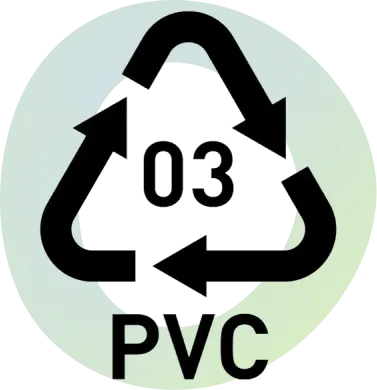Polyvinyl Chloride (PVC)
Polyvinyl Chloride PVC Recycling
Reclaim
Polyvinyl chloride, often referred to as “PVC”, or “vinyl”, is a thermoplastic commonly used for its hardness and strength, as well as its chemical resistance. Rigid PVC, also known as uPVC or RPVC (unplasticized or rigid PVC, respectively), is often used as piping in the plumbing, sewage, and agricultural industries. PVC is an attractive material for these applications due to its relative low cost, and high durability while still remaining lightweight [1].
Flexible PVC on the other hand (also referred to as “plasticized” PVC, due to the addition of plasticizers) can be used as a replacement for rubber for the purposes of insulating electrical wiring, or as flooring in environments where sterility is important (such as in hospitals). However, since PVC can release hydrogen chloride fumes when burned, in addition to its poor heat stability (without the addition of stabilizing additives), PVC is often used in low-heat environments where the risk of burning is lowered [1].
Nevertheless, PVC remains one of the most in-demand plastics worldwide, with upwards of 20 million tons of PVC being produced globally, every year [2]. As a result, finding adequate recycling solutions to reduce the amount of PVC entering our landfills is of high priority.
Most PVC plastic recycling takes one of two forms. PVC can be mechanically recycled much like other rigid plastics, first by separating out any impurities, then grinding and melting the resulting plastic granules before being reintroduced into the manufacturing process, or PVC can be chemically recycled, converting the vinyl into individual chemical components such as sodium and calcium chloride, which can either be used in the production of new plastics, or in different applications altogether [3].
With more countries looking to shift to more environmentally conscious policies, such as through the banning of PVC from entering landfills in certain European countries [3], more focus on the recycling of this conventionally difficult to recycle material is in order – a challenge that we are fully prepared to take on.

Polyvinyl chloride has a resin identification code of 3.
References
[1] Creative Mechanisms Staff, “Everything You Need To Know About PVC Plastic,” Creativemechanisms.com, Jul. 06, 2016. https://www.creativemechanisms.com/blog/everything-you-need-to-know-about-pvc-plastic (accessed Jul. 28, 2021).
[2] PVC Enterprise, “PVC Recycling,” www.pvcenterprise.com. https://www.pvcenterprise.com/recycling-plastic-waste/pvc-recycling.html (accessed Jul. 28, 2021).
[3] M. R. Rubio, “Recycling of Polyvinyl Chloride | BioEnergy Consult,” BioEnergy Consult, Jan. 02, 2021. https://www.bioenergyconsult.com/recycling-polyvinyl-chloride/ (accessed Jul. 28, 2021).

Carstar
“We are proud to recycle our scrap bumper plastics rather than add to the landfill. Reclaim has helped us do this.”
Kris Kurman
Manager
Schedule an appointment today!
Reclaiming our environment by Reclaiming the plastic waste we produce.

